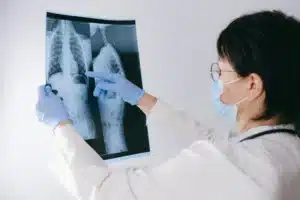
Menu

Have you ever encountered a patient complaining of severe pain in the mid-back area and wondered about the most accurate way to code this in ICD-10? If you’re a healthcare provider in the medical billing industry, understanding ICD-10 thoracic pain coding is crucial for accurate patient records and billing. Exploring the complexities of ICD-10 can be challenging, especially when dealing with the nuanced differences in thoracic pain diagnoses.
This guide aims to demystify these complexities, offering clear, detailed insights into the coding process. Whether you’re dealing with acute or chronic thoracic pain, understanding the specific codes and their application is key to ensuring effective treatment plans and seamless insurance processing.
Stay ahead in your practice with this essential guide, tailored to enhance your coding proficiency and optimize patient care.
Thoracic pain refers to discomfort or pain in the thoracic region of the spine, which comprises the middle part of the back between the cervical and lumbar vertebrae. It’s a common issue among patients, often characterized by a sharp, burning, or dull ache. Accurately coding thoracic pain in ICD-10 ensures effective treatment plans and proper insurance claims.
The ICD 10 code for thoracic back pain is M54.6. This code is essential for healthcare providers for accurate diagnosis reporting and billing.
When diagnosing thoracic pain, healthcare providers must consider several factors. Firstly, a thorough patient history and physical examination are essential. Providers should inquire about the nature, duration, and intensity of the pain, along with any activities that aggravate or alleviate it. Imaging studies like MRI or CT scans might be recommended to rule out structural issues.
Secondly, correlating clinical findings with ICD-10 codes is crucial. M54.6 should be used when thoracic pain is the primary diagnosis, but other codes may apply if the pain is symptomatic of another condition, such as a herniated disc or osteoarthritis.
| Condition | ICD-10 Code |
|---|---|
| Acute Thoracic Pain | M54.2 |
| Chronic Thoracic Pain | M54.3 |
| Feature | Upper Back Pain (M54.6) | Lower Back Pain (M54.5) |
|---|---|---|
| Location | Between cervical and lumbar | Lumbar region |
| Common Causes | Muscle strain, overuse | Disc degeneration, sciatica |
| Associated Symptoms | Stiffness, limited motion | Radiating leg pain |
| Treatment Approaches | Physical therapy, NSAIDs | Steroid injections, surgery |
Muscle Tension:
muscle tension in the thoracic spine is a prevalent condition often attributed to lifestyle factors like poor posture or prolonged sitting, especially in people with sedentary jobs or those who spend long hours in front of computers. This condition results from the muscles in the upper and mid-back regions becoming overstretched or overstrained, leading to discomfort and pain.
The pain can range from a mild, nagging ache to severe, debilitating discomfort, depending on the duration and intensity of the muscle tension. Treatment typically involves a combination of physical therapy, posture correction exercises, and relaxation techniques.
In some cases, addressing ergonomic issues at the workplace and incorporating regular movement or stretching breaks into the daily routine can significantly alleviate muscle tension.
Vertebral Fractures
Vertebral fractures in the thoracic region are a serious concern, particularly in patients with osteoporosis, a condition that weakens bones and makes them more susceptible to fractures.
These fractures can occur even with minor trauma or, in severe cases, with everyday activities. The pain associated with vertebral fractures is typically sharp and can be debilitating. It may lead to a decrease in mobility and a significant impact on the patient’s quality of life. Diagnosis often involves imaging techniques like X-rays, CT scans, or MRIs.
Treatment for vertebral fractures may include pain management, physical therapy, and in some cases, surgical intervention. Additionally, addressing the underlying osteoporosis through medication and lifestyle modifications is crucial to prevent further fractures.
1: Advanced Physiotherapy Techniques:
Targeted Exercises: These are specially designed exercises that focus on strengthening and stabilizing the muscles surrounding the thoracic spine. By improving muscle function, these exercises help in alleviating pain and enhancing range of motion. They are tailored to each patient’s specific condition, ensuring that they address the individual’s unique pain points and weaknesses.
Manual Therapy: This involves hands-on techniques performed by trained physiotherapists to manipulate and mobilize the spine and surrounding tissues. Techniques such as massage, mobilization, and manipulation help reduce pain, increase flexibility, and improve blood circulation in the affected area.
Use of Smart Technology: The integration of smart technology in physiotherapy is a significant advancement. Wearable devices, virtual reality (VR), and mobile apps can now track patient movements, provide real-time feedback, and offer customized exercise regimes. This technology not only enhances patient engagement and adherence to the therapy but also allows for precise monitoring of progress, leading to more effective treatment outcomes.
2: Minimally Invasive Spine Surgery:
Overview: Minimally invasive spine surgery (MISS) is a technique that uses smaller incisions than traditional open surgery, resulting in less damage to the surrounding tissues. This approach leads to a quicker recovery, reduced pain post-surgery, and a lower risk of complications.
Laser Spine Surgery: A subset of MISS, laser spine surgery, uses a focused beam of light (laser) to remove soft tissues over the spine and to treat spinal conditions causing thoracic pain. It’s particularly useful in removing small areas of herniated or damaged discs without affecting the surrounding healthy tissues.
Benefits: The key benefits of minimally invasive spine surgery include reduced hospital stays, lesser need for pain medications, minimal scarring, and a faster return to daily activities. Also, the precision of these procedures often leads to more effective pain relief and a lower risk of recurrent spine problems.
ICD-10 code M54.9 is used for ‘dorsalgia, unspecified,’ indicating back pain without a specific underlying cause. It’s a general code for back pain that doesn’t specify the exact region or cause, often used when the diagnosis is uncertain or awaiting further investigation.
Treatment for unspecified dorsalgia (M54.9) typically involves a combination of approaches. Conservative treatment like physical therapy and pain management with NSAIDs is often the first step. If the pain persists, further diagnostic tests are recommended to identify the underlying cause and tailor the treatment accordingly.
Regular Exercise: Strengthening the core muscles helps support the back.Ergonomic Adjustments: Proper sitting posture and ergonomic workplace setups.
Stress Management: Techniques like meditation and yoga can alleviate stress-induced back pain.
Mastering ICD-10 coding for thoracic pain disorders is a vital skill for healthcare providers, enhancing patient care through precise diagnosis and treatment. This guide has covered the essentials, from understanding thoracic pain and its causes to navigating the specifics of ICD-10 coding, including recent updates and treatment innovations. By applying this knowledge, practitioners can ensure accurate diagnosis, effective treatment plans, and smooth insurance processes. Remember, accurate coding is not just about paperwork; it’s about understanding the patient’s journey and contributing to their path to recovery.



